This is a list of the naval forces from the United Kingdom that took part in the Falklands War, often referred to as "the Task Force" in the context of the war. For a list of naval forces from Argentina, see Argentine naval forces in the Falklands War.

The Exocet is a French-built anti-ship missile whose various versions can be launched from surface vessels, submarines, helicopters and fixed-wing aircraft.
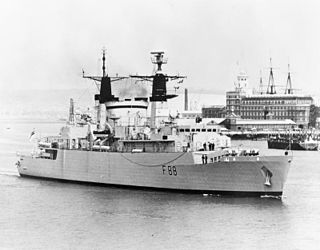
HMS Broadsword was the lead ship and first Batch 1 unit of the Type 22 frigates of the Royal Navy.

HMS Brilliant was a Type 22 frigate of the Royal Navy.
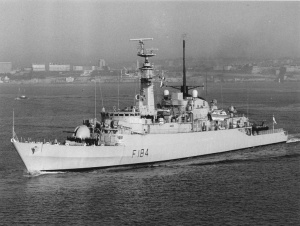
HMS Ardent was a Royal Navy Type 21 frigate. Built by Yarrow Shipbuilders Ltd, Glasgow, Scotland. She was completed with Exocet launchers in 'B' position. Ardent took part in the Falklands War, where she was sunk by Argentine aircraft in the Falkland Sound on 21 May 1982.

HMS Avenger was a Type 21 frigate of the Royal Navy. Built by Yarrow Shipbuilders Ltd, Glasgow, Scotland, she was completed with Exocet launchers in 'B' position.

HMS Sheffield was a Type 42 guided missile destroyer and the second Royal Navy ship to be named after the city of Sheffield in Yorkshire. Commissioned on 16 February 1975 the Sheffield was part of the Task Force 317 sent to the Falkland Islands during the Falklands War. She was struck and heavily damaged by an Exocet air-launched anti-ship missile from an Argentine Super Étendard aircraft on 4 May 1982 and foundered while under tow on 10 May 1982.

HMS Glasgow was a Type 42 destroyer of the Royal Navy. The last of the Batch 1 Type 42 destroyers, Glasgow was commissioned in 1979. The destroyer fought during the Falklands War, and on 12 May 1982 was damaged by a bomb from an Argentine A-4 Skyhawk. Glasgow was part of the Royal Navy’s 3rd Destroyer Squadron along with HMS York, HMS Edinburgh and HMS Liverpool. The 3rd Destroyer Squadron was based in Rosyth during the 1980s and early 1990s before being moved to Portsmouth when Rosyth Dockyard was privatised and re-purposed. The destroyer was decommissioned in 2005 and was broken up for scrap in 2009.

HMS Coventry was a Type 42 (Sheffield-class) destroyer of the Royal Navy. Laid down by Cammell Laird and Company, Limited, at Birkenhead on 29 January 1973, she was launched on 21 June 1974 and accepted into service on 20 October 1978 at a cost of £37,900,000.

HMS Antrim was a County-class destroyer of the British Royal Navy launched on 19 October 1967. In the Falklands War, she was the flagship for the recovery of South Georgia, participating in the first ever anti-submarine operation successfully conducted exclusively by helicopters. In 1984, she was commissioned into the Chilean Navy, and renamed Almirante Cochrane.
This article describes the composition and actions of the Argentine naval forces in the Falklands War. For a list of naval forces from the United Kingdom, see British naval forces in the Falklands War.

HMS Argonaut (F56) was a Leander-class frigate that served with the Royal Navy from 1967 to 1993. She took part in the Falklands War in 1982, sustaining damage and casualties in action.
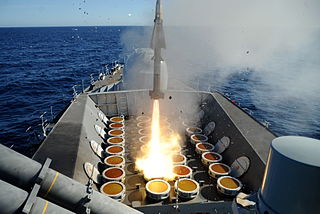
Sea Wolf is a naval surface-to-air missile system designed and built by BAC, later to become British Aerospace (BAe) Dynamics, and now MBDA. It is an automated point-defence weapon system designed as a short-range defence against both sea-skimming and high angle anti-ship missiles and aircraft. The Royal Navy has fielded two versions, the GWS-25 Conventionally Launched Sea Wolf (CLSW) and the GWS-26 Vertically Launched Sea Wolf (VLSW) forms. In Royal Navy service Sea Wolf is being replaced by Sea Ceptor.

HMS Plymouth was a Royal Navy Rothesay-class frigate. In 1982, Plymouth was one of the first Royal Navy ships to arrive in the South Atlantic during the Falklands War.
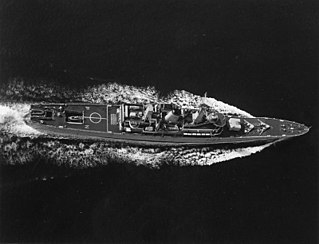
HMS Penelope was a Leander-class frigate of the Royal Navy. In the Falklands War, Penelope fired on an Argentine patrol boat and claimed to be the last ship attacked by Argentine aircraft over the course of the war. In 1991, she was commissioned into the Ecuadorean Navy, and renamed Presidente Eloy Alfaro.
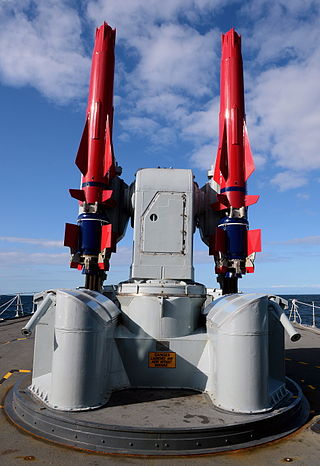
Sea Dart, or GWS.30 was a Royal Navy surface-to-air missile system designed in the 1960s and entering service in 1973. It was fitted to the Type 42 destroyers, Type 82 destroyer and Invincible-class aircraft carriers of the Royal Navy. Originally developed by Hawker Siddeley, the missile was built by British Aerospace after 1977. It was withdrawn from service in 2012.
These are some of the key weapons of the Falklands War used by both sides.

HMS Lawford (K514) was a Royal Navy converted Captain class frigate, built in the US in 1944. She was converted into an HQ ship for the Normandy landings. On 8 June 1944, whilst operating off Juno Beach, she was hit by enemy fire during an air attack and sunk. Thirty-seven of her crew died. The Royal Navy's damage summary report states that the ship was hit by an "aerial torpedo", which has been taken to mean a torpedo dropped from an aircraft. However, a survey of the ship undertaken as part of the Channel 4 TV series "Wreck Detectives" found evidence that the vessel was broken up and sunk by an internal explosion, indicating a hit from one or more bombs or from an early guided missile such as an Hs-293 or a Fritz X.
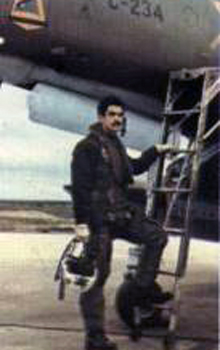
Commodore Pablo Marcos Rafael Carballo is a retired member of the Argentine Air Force - the Fuerza Aérea Argentina (FAA) - who fought in the 1982 Falklands War where he participated in actions that led to the sinking of three Royal Navy ships. He was awarded the highest national military decoration: the Argentine Nation to the Heroic Valour in Combat Cross, the Argentine Congressional Medal, and the Highest Distinction of the Argentine Air Force.
The Battle of San Carlos was a battle between aircraft and ships that lasted from 21 to 25 May 1982 during the British landings on the shores of San Carlos Water in the 1982 Falklands War. Low-flying land-based Argentine jet aircraft made repeated attacks on ships of the British Task Force.
















